I thought, at the risk of boring the pants off everyone, that I’d post a single thread about a few incomings I’ve had of late (when I say of late, they actually span some four months). Some planned and others not, there’s a real mix of styles and all of them are quite interesting in one way or another. Hopefully you’ll enjoy the read and the photos, anyway.
Zenith Chronomaster Sport
The root of this acquisition goes back many years, when I was promised a ceramic Daytona by the manager of a branch of WoS the location of which shall remain nameless. The Daytona in its new guise was a bit of a grail watch for me, and I’d previously bought not only a new Datejust for my other half from the shop’s stock but also the manager’s own AP Royal Oak from his personal collection.
I knew him pretty well by the time the Daytona conversation took place and had even been on an overseas trip with him. When he promised me a watch within 6 months I knew he meant it, but what I hadn’t allowed for was his subsequent heart attack and early retirement. The new manager proceeded to completely take the piss with false promises and outright lies, until he finally admitted I wasn’t on “his” list any longer. Nice, right?
Anyway, long story short and – since then – I’d been looking fruitlessly for an affordable example to no avail (yes, for years, having made the decision that I wasn’t going to pay the crazy prices being asked by the greys). Ultimately, I decided to give up and look for something else, not realising that the perfect alternative had been released by Zenith in the form of the Chronomaster Sport. Some threads on TZUK led me to look into it further, and the more I looked the more I liked. In fact, I very quickly decided that it was more than just a substitute – it’s a superb watch in its own right.
It’s slightly larger than the Daytona at 41mm but doesn’t have the appearance of bulk, helped by the relatively short lugs and the fact that its not “all dial”. The classic tri-colour subdials with their concentric circles look absolutely wonderful. In fact, the overlapping sub-dials and colour scheme go all the way back to the 1969 El Primero A386 and according to Zenith the general configuration of the case was inspired by the De Luca. The ceramic bezel – which changes from back to a matt grey depending on the light – just finishes the whole package perfectly.
Inside, though, it’s really interesting, housing as it does Zenith’s most recent iteration of the El Primero movement – the cal. 3600. In fact, a hint of what’s inside can be seen on the aforementioned bezel. Marked off in increments of 1/10th of a second it reflects the ten seconds that it takes the main chronograph hand to traverse the dial once.
There are a host of technical innovations in this new movement and – rather than bore everyone with them here – I’ll link to the Hodinkee article that explains them better than I could. However, I will say that the engine in this watch is a clear leap forward from the aging cal. 400 movement that’s been around for decades.
Fast forward, then, and a few nights ago a friend and I met in central London, consumed copious amounts of gin, and concluded a deal that saw me part with a large sum of cash in return for which I left with his watch. I’ve been wearing it since then and I’m beyond thrilled with it. In fact, I love everything about the Chronomaster Sport, and will no longer be wasting my time fruitlessly pursuing the mythical Daytona. I actually think that this is a better watch, and it’ll be with me for the very long term.



Vacheron Constantin Fiftysix Day-Date
Now, this one really did take me by surprise, as although I’d been fending off an increasing desire for a day-date my thoughts had previously turned to the more traditional solution in the form of the classic Rolex. I really do like them and have done for a long time, but they represent a pretty major investment so I’d really just been biding my time until something irresistible found its way to me.
Now, I’d also been fending off another friend from TZUK who’d been pestering me for months for one of my watches (a watch that he actually sold to me and wanted back – and not for the first time, either). I’d declined some trades for beautiful watches, but when this one came up for grabs it was a pretty easy yes. Not just because I loved the watch, but also because I could plan (at the time) for the mythical Daytona’s arrival by selling my Overseas Chrono. It would also mean that I didn’t have two VCs in a relatively small collection and, in any event, I kind of felt like I wanted to move it on to invoke some change or other.
Anyway, the Fiftysix Day-date is a sublime thing. Here’s what VC themselves say about it on their website:
With horns inspired by the sides of the Maltese cross, an integrated crown, and sapphire glass this steel watch honours a model from 1956. It displays the power reserve, a day-date indicator, and seconds on the dial. Its openworked caseback reveals an elevated oscillating weight in 22K gold, inspired by the Maltese cross.
All good so far, then, and – at 40mm – it’s a perfect size for nearly everyone. The movement, bearing the Geneva Seal, contains 264 parts and 27 jewels, has a power reserve of 40 hours, and has a frequency of 28,800 bph.
The Fiftysix collection was designed with VC’s historic model 6073 from 1956 in mind (as mentioned in the quote above). See the connection? Anyway, aside from looking gorgeous in a kind of classic yet contemporary way, inside is a work of art. I can honestly do no better than to quote a rather lovely piece of prose from the Mr Porter website:
The Fiftysix Day-Date is powered by Vacheron Constantin’s calibre 2475 SC/2, an automatic movement with a 40-hour power reserve, beating at 4Hz. Like all Vacheron Constantin movements, it is manufactured to meet the standards of the Poinçon de Genève. Often referred to as the Geneva Seal or Geneva Hallmark, this is an independently regulated mark of quality that’s among the most exacting in the industry. Not only does it demand that the watch measure up when it comes to accuracy, water-resistance, power reserve and all other functional claims, but it places strict requirements on the maker to use the best possible practices in the design and finishing of the movement itself.
If you were to imagine this movement – with its 264 components – as an orchestra playing in harmony, the requirements of the Poinçon de Genève elevate that orchestra to London Symphony or Berlin Philharmonic levels. Hence, you will find details such as radial Côtes de Genève finishing on the side of the movement plates hidden under the dial, never to be seen by anyone other than the watchmaker who services the watch. Every edge is perfectly bevelled, every jewel pristine; every screw-head polished and fitted in a matching countersink. Every surface is given some level of finish; in short, a truly virtuoso performance.
There you have it, then. “It’s a day-date, Jim, but not as we know it.”



Sinn U50
Okay, this one is going to demand a lot less time to read. Long story short, I’ve owned about half a dozen of the U series watches from Sinn, loving every one whilst eventually realising that they’re just a bit too big for me. Shades of the MM300, in fact, but not nine of them, at least!
When the 41mm U50 was released, then, it immediately appealed and I ended up ordering the fully tegimented version (that is, case, bezel and bracelet all with the hardened finish) form Jura watches. Nine months later I was still waiting for my bloody watch, irritating all the more because mine was the only outstanding order. I ended up losing all patience and cancelled the order, suffering further through the three week wait to receive my refund. As for Jura… well, never again.
Eventually, I managed to bag a minter on TZ-UK, again fully tegimented so all ended up well in the end. In fact I subsequently picked up the rubber strap/clasp combo too, and that’s how I’ve been wearing it after a little experimentation with nylon. Sinn use Sellita movements these days, of course, but it runs very well and looks just like a U1. Only smaller.

And finally… drum roll, please…
Seiko SKX007
Well, it’s not just a 007, its an M&S 007. Or rather, a 007 modded by a bloke in the US to give it a vintage vibe, after which it then had an NH36 movement dropped in it. It now not only looks lovely but is hacks and handwinds. It runs at +14spd but the spec for the NH36 is -25 to +35spd, so it’s well within those parameters. And, seriously, could there be a better summer beater than this? No, of course there couldn’t!

Okay, that’s it. Four months-worth of horological excitement rolled into one little post with a few pretty pictures. Hope you enjoyed it.






















































